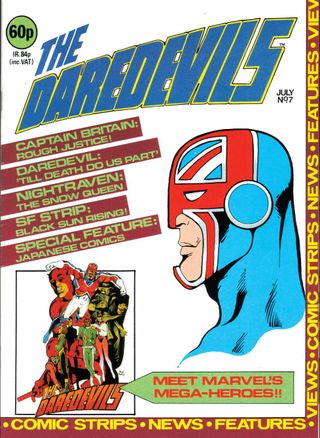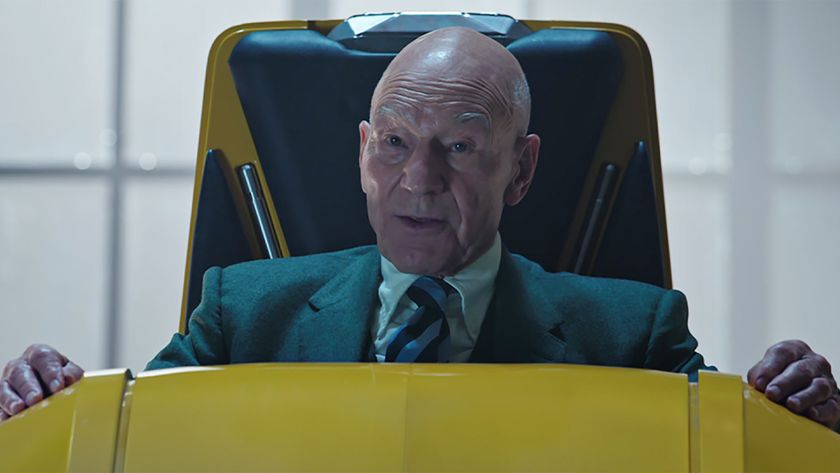How the Marvel Universe became "Earth-616" and grew into an entire Multiverse
How did the Marvel Comics Multiverse begin, and how did the Marvel Universe get the name Earth-616?

Loki season 2 episode 6 is now streaming. And while we won't spoil any of the details of the season finale, we will say that the main MCU timeline is referred to as "the 616," just like it was recently in Spider-Man: Across the Spider-Verse.
And of course, back in Doctor Strange in the Multiverse of Madness and Spider-Man: Far From Home before that, the MCU reality is called Earth-616, which is the same designation given to the core Marvel Comics reality.
Why the difference? Probably to avoid confusion and to make clear that there aren't two realities called Earth-616. As for the in continuity question of why the MCU calls itself Earth-616 instead of Earth-19999, the only answers right now are purely speculative.
Still, it begs the question of exactly who cataloged and numbered the many realities of the Marvel Multiverse to begin with, both in terms of the real world, and in the continuity of the Marvel Universe?
With the MCU currently in the thick of the Multiverse Saga, Newsarama thought it high time we looked at the origin and history of the original comic book concept to answer some basic questions and explain the semi-obscure numerical designations of the Marvel realities - as well as how Alan Moore, co-creator of DC's seminal story Watchmen , may be involved.
The Marvel Comics Multiverse

The roots of Marvel's Multiverse go back to the earliest days of Marvel Comics itself, in the '60s. Though it wouldn't be formally named till later, the core Marvel Universe's first brush with another reality happened all the way back in 1962's Strange Tales #103, in which Johnny Storm of the Fantastic Four is transported to an alt-universe called the Fifth Dimension, later designated Earth-1612 of the Multiverse.
After that, 1963's Fantastic Four #10 sent Doctor Doom to the microscopic realm of Sub-Atomica. And that same year in Fantastic Four #19, the team found themselves sent back through time to face Rama-Tut, a time-traveling villain later revealed as one of the many identities of Kang the Conqueror, progressing the idea even further by showing the so-called 'Other-Earth' where Kang resides. Again, 'Other-Earth' was later incorporated fully into the Multiverse under the numeric designation Earth-6311.
Comic deals, prizes and latest news
Get the best comic news, insights, opinions, analysis and more!
Then, 1964's Strange Tales #126 ramped the concept of Marvel's alt-realities up again by sending Doctor Strange into the Dark Dimension, home of his arch-foe the dread Dormammu - an alternate world full of non-euclidean geometry, and incomprehensible cyclopean architecture rendered to psychedelic perfection by artist Steve Ditko.
From there, Reed Richards led the Fantastic Four to pioneer Multiverse travel again in 1968's Fantastic Four Annual #6, in which he built the first machine designed to travel between realities, taking his family into the Negative Zone, an antimatter universe full of deadly horrors.

And in 1969, The Avengers took the leap, traveling to 'Earth S' (later numbered Earth-712), the home of the Squadron Supreme, analogs of DC's Justice League who later went on to headline their own title set on Earth-712 - and who recently played a key part in yet another alt-reality tale in this summer's Heroes Reborn limited series.
Then the '60s became the '70s, and a new crop of writers came to the Marvel Universe with more outlandish, cosmic visions than even Stan Lee and Jack Kirby had already pioneered, and with that, the Marvel Multiverse broke wide open.
Throughout the decade, writers introduced numerous alt-realities as elements of new stories, and many previous concepts, like Sub-Atomica (which became part of the Microverse), were revisited and expanded upon. All of this culminated in 1977's What If? #1, which launched a whole ongoing title showcasing alternate versions of the Marvel Universe where characters and events that readers knew took on wildly different identities or outcomes.
By the '80s the Marvel Multiverse was in full swing, with writers free to come and go from any universe they could dream up for their characters. However, where Marvel's Multiverse was wide open to writers, the rules that would later define it - and even the term 'Multiverse' - hadn't yet been established. It was a multiverse of madness, so to speak.
So how did the Marvel Universe become Earth-616, and how did the other Earths get their numbers?
Calculating Infinity

Though the Marvel Comics Multiverse was a playground for creators by the '80s, unlike Marvel's closest rivals DC's version of the concept, the mechanics, specific worlds, and implications of the Multiverse hadn't been cataloged and codified (or been totally broken) by the publisher yet.
This started to change around the time Marvel kicked off What If? (the inspiration for the Disney Plus animated series) in 1977. Editor Mark Gruenwald (known for inspiring Mobius M. Mobius of the Time Variance Authority or TVA, also adapted in Disney Plus' Loki show) laid out a concept that included a nested version of multiple realities, which incorporated most of Marvel's alt-realities and dimensions up until that point, using the term 'Multiverse' for the first time.
Gruenwald's structure extrapolated past the Multiverse into what Gruenwald coined an 'Omniverse,' which, in Gruenwald's estimation, branched out past just the worlds of Marvel's multiverse to encompass all possible worlds of fiction - even from other comic book publishers - as well as the actual real world that we all live in.
The numbering of the Marvel Multiverse has a separate, somewhat mysterious origin all its own, which starts in what may as well have been another reality for Marvel Comics at the time - the UK.
In the '60s, '70s, and into the '80s, most Marvel Comics were not directly imported to the UK and other overseas markets on a one-to-one basis. Instead, overseas publishers would license Marvel's stories for republication, sometimes localizing, re-editing, or collecting the stories in different ways than US fans got them. Over time, Marvel UK became something of its own separate side-branch of the Marvel Universe, with its own unique characters and titles that were tied to their US equivalents, but who very rarely crossed over in their early years.
Numerous British and UK-based creators who went on to become top names in the mainstream industry got their start working with US publishers through Marvel UK before branching out across the pond - including none other than Alan Moore, co-creator of Watchmen, known for his knack for breaking down, rebuilding, and redefining superhero concepts through a more nuanced lens.

In fact, it was partially Moore who named the Marvel Universe 'Earth-616,' in 1983's Daredevils #7 (a Marvel UK anthology title that had no relation to the singular blind hero Daredevil) in a story featuring Captain Britain, who had been established as just one of multiple heroes guarding their home realities across the Multiverse as part of the Captain Britain Corps.
However, there's a bit of mystery and controversy around how the Earth-616 designation first made it into Captain Britain, and why that particular number was chosen. Alan Davis, the story's artist, claims it was David Thorpe, Moore's predecessor as Captain Britain writer, who first coined the term, though Moore maintains he came up with it himself.
According to Moore, the number 616 was chosen at random to avoid using the terms 'Earth-One' or 'Earth-Two,' as used by DC. However, there are alternative ideas about how the worlds of Marvel's Multiverse get their numbers. A common belief is that the number 616 was chosen to honor the year and month of Fantastic Four #1's 1961 debut, which launched the Marvel Universe - and indeed some of Marvel's numbered worlds get their designations from this formula.
However, in a 2020 interview, Thorpe himself seems to settle the entire dispute on some level, agreeing with Davis that he is the one who invented the term 'Earth-616.' Thorpe states he came up with the number through numerology, of which he was a student at the time, subtracting the number 50 from the number 666 (a number tied to Christian theology) to arrive at 616 as the home reality of the Marvel Universe - though he also accedes that it was indeed Alan Moore who first put the term in print, leading to the term being adopted on a larger scale.
Whatever the nuances of its true origin, the term 'Earth-616' was taken as canon into the broader Marvel Universe just a few years later when Captain Britain became a core member of the US-published Marvel mutant team Excalibur, with none other than Alan Davis helping codify the concept's relation to the wider Marvel Universe as the artist of Excalibur alongside longtime X-Men writer Chris Claremont.
From there, Marvel's other realities were mapped out and numbered behind the scenes, with realities that have debuted since getting numbers derived by their creators. And though there have been attempts to alter the Earth-616 designation along the way, it's stuck around as canon - apparently even into the Marvel Cinematic Universe, at least on some level.
In the years after the 616 became mainstream Marvel lore, whole separate universes of continuity sprung up, such as the Marvel 2099 line, which took place in a possible future timeline, and the Ultimate Comics line, which was an entire parallel Marvel Universe based on Earth-1611.
And for the most part, the Marvel Multiverse and its numbered realities have stuck around - more or less...
The modern Marvel Multiverse

In 2014, Marvel Comics launched a limited series titled Secret Wars, which took its name from a Marvel event 30 years earlier. In that story, all the worlds of Marvel's Multiverse are essentially destroyed one by one, with the last shreds of existence saved by Doctor Doom, who uses his mastery over science and magic to pull the remaining pieces of the Multiverse together into a single hodge-podge reality called Battleworld.
When the dust cleared on Secret Wars a year later, the Marvel Multiverse had been totally demolished, not too different from DC's 1985 Crisis on Infinite Earths. However, instead of rebooting its continuity or shying away from a reborn multiverse the way DC did for decades after Crisis, Marvel immediately rebuilt its multiverse, taking the opportunity to incorporate aspects of alt-realities, such as the Ultimate line which ended with the collapse of the Multiverse, into its core Earth-616 continuity.
Interestingly, however, some of Marvel's top creative executives at the time, chief creative officer Joe Quesada and executive editor Tom Brevoort, also took the opportunity to divest and downplay the term 'Earth-616' and the other numeric Multiverse designators from use on the page, having publicly stated their own distaste for the terminology.
Though the change has stuck around somewhat on the page, with the Multiverse numbers rarely getting any references these days, the 616 terminology has become more prevalent than ever outside of Marvel Comics thanks to its use by Marvel Studios - who have not only namechecked the concept on film and TV, but who named a whole behind-the-scenes documentary show Marvel's 616 after the idea.
Now, the MCU is diving straight into the Multiverse concept in a big way, with numerous recent films and series tapping directly into the idea as part of the 'Multiverse Saga.'

There's one big, odd MCU/Marvel Comics coincidence (or planned synchronicity?) between the kick-off of the MCU Multiverse and its comic book counterpart. As in the MCU, one of the first characters from another reality introduced in Marvel Comics was a variant of Kang the Conqueror. In comics, this variant was Rama-Tut, while in the MCU, it's He Who Remains (himself a bit of a mash-up between the comic book character of that name and Kang's comic book variant Immortus).
Kang's reality of Earth-1612 was one of the very first alt-realities explored in Marvel Comics, though it wasn't numbered until many years later in What If? Vol. 2 #39, in a story titled 'What if the Watcher saved the Multiverse?"
In that story, Uatu the Watcher - the cosmic observer who is but one of many Watchers who catalog the Multiverse, vowing never to interfere - breaks his oath and steps in to stop a war between Kang and Immortus that causes wild, branching realities to spawn.
Sounds quite a bit like the premise of the MCU Multiverse laid out in the final episode of Loki's first season, in which countless variants of Kang are vying for multiversal conquest, doesn't it?
Kang made quite the impression in Ant-Man: Quantumania. But who exactly is he and what are his powers?
I've been Newsarama's resident Marvel Comics expert and general comic book historian since 2011. I've also been the on-site reporter at most major comic conventions such as Comic-Con International: San Diego, New York Comic Con, and C2E2. Outside of comic journalism, I am the artist of many weird pictures, and the guitarist of many heavy riffs. (They/Them)












